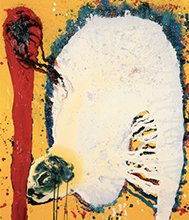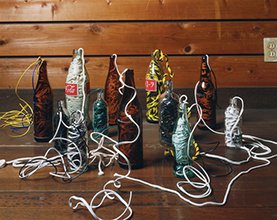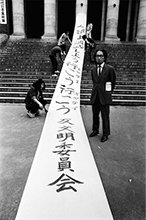The Emergence of the Contemporary: Avant-Garde Art in Japan, 1950-1970
Brazil’s First Exhibition Devoted to the Japanese Avant-Garde Movement
Left: Sadamasa Motonaga, Work, 1961
Center: Jiro Takamatsu, Strings in Bottles, 1963 Photo: Tadasu Yamamoto ©The Estate of Jiro Takamatsu, Courtesy of Yumiko Chiba Associates, Tokyo, Fergus McCaffrey, New York and Stephen Friedman Gallery, London
Right: Mitsutoshi Hanaga, Yutaka Matsuzawa 10th Contemporary Japanese Art Exhibition, 1971. Exhibition Participants: Shusaku Arakawa, Sho Kazakura, Tatsuo Kawaguchi, Tetsumi Kudo, Jiro Takamatsu, Shintaro Tanaka, Play, Tadashi Maeyama, Yutaka Matsuzawa, Jun Mizukami, Masunobu Yoshimura, and others.
The Japan Foundation holds the exhibition The Emergence of the Contemporary: Avant-Garde Art in Japan, 1950-1970 in Rio de Janeiro, from July to August 2016.
This exhibition has been organized by the Japan Foundation as part of a comprehensive program encouraging cultural collaboration between Japan and Brazil through visual arts, movies (film screenings), and performing arts (music concerts). The program, running from July to August, has been orchestrated in advance of the Rio de Janeiro Olympic and Paralympic Games, as a way of “passing the baton” from Rio to Tokyo, the next host city of the Games.
The exhibition is the first on Brazilian soil to focus on the avant-garde movement in Japanese visual arts between the 1950s and the 1970s. It comprises around 70 highly experimental works showcasing the diversity of the Japanese art scene, from the abstract expressionism of the Gutai Group and the Jikken Kobo (Experimental Workshop) renowned across the international art scene at the time, and the architecture and art inspired by contemporary thought that pushed Japanese society in new directions, to performance pieces questioning the meaning of the human body, and the concrete poetry and works of the Mono-ha artists pursuing the relationship between words and objects. When these works were produced was an economically and societally turbulent period, and major events such as the 1964 Tokyo Olympics triggered the production of innovative works by many artists and architects. Setting this exhibition in the city of Rio de Janeiro, currently undergoing a similar period of great change itself, provides a fantastic opportunity not only to look back at this era of Japanese history so overflowing with vitality, but also to form links between the 1964 Tokyo, 2016 Rio de Janeiro, and 2020 Tokyo Olympics. We hope it will offer a chance for these two nations to come together in setting their sights on the future together.
Divided into four sections—“Politics of Abstraction,” “Art and Social Engagement,” “Interventions in Urban Space,” and “Matter, Concept, and Art” —the exhibition presents works in a variety of media, from paintings, including the posters of the Tokyo Olympics, three-dimensional works, video, design, and publications to performance.
The show features a performance originally conducted by the artist group Hi-Red Center in Tokyo in 1964, as recreated and reinterpreted in 2016 in Rio de Janeiro by young Rio artists. Another work created for this exhibition is a new Rio version of architect Arata Isozaki’s Incubation Process, which was first exhibited in 1962. There are also numerous other precious works that cannot be seen elsewhere, including an installation that recreates Work (Water) by leading Gutai artist Sadamasa Motonaga for the Paço Imperial space, and a new installation, Cultivation of Critical Spaces, by leading Mono-ha artist Suga Kishio. For more information about associated movie screenings(Japanese) and concerts, please visit the Japan Foundation website.
Outline
| Dates | Thursday, July 14 - Sunday, August 28, 2016 |
|---|---|
| Venue | Paço Imperial, Rio de Janeiro |
| Curator | Pedro Erber (Associate Professor, Cornell University) |
| Curatorial Adviser | Katsuo Suzuki (Curator, National Museum of Modern Art, Tokyo) |
| Organizers | The Japan Foundation, Paço Imperial |
| Special Support | Ishibashi Foundation
|
| Support | Lufthansa Cargo AG |
Exhibition Details
Installation View
Paço Imperial
Originally constructed as a residence for government officials in the 18th Century during the Portuguese colonial era, the Paço Imperial came to be used as an imperial palace in the early 19th century. Since 1984, it has served as one of Rio’s most important cultural centers, used for showing visual arts, music and films. Located in Rio’s city center, the Paço Imperial is a familiar historical building to residents, and also a popular sightseeing destination.
Pedro Erber (Curator, Associate Professor at Cornell University)
As well as teaching the Brazilian intellectual history, literature, and visual culture at Cornell University, Erber is active as a researcher whose interests include the comparative study of Japanese and Brazilian post-war art and intellectual thought. After receiving a research fellowship from the Japan Foundation to study in Japan, where he pursued topics including Japanese art and intellectual history in the post-war period, Erber published his book Breaching the Frame: The Rise of Contemporary Art in Brazil and Japan.
[Contact Us]
The Japan Foundation
International Operations Section I, Arts and Culture Dept.
Person in charge: Saito (Mr.), Okabe (Ms.), Suzuki (Ms.)
Tel: +81-(0)3-5369-6061 / Fax: +81-(0)3-5369-6038
E-mail: arts1@jpf.go.jp
(When sending an e-mail, please enter a half-width character "@" instead of a full-width character "@.")
- What We Do Top
- Arts and Cultural Exchange [Culture]
- Japanese-Language Education Overseas [Language]
- Japanese-Language Education Overseas [Language] Top
- Learn Japanese-language
- Teach Japanese-language
- Take Japanese-Language Test
- Know about Japanese-language education abroad
- The Japanese-Language Institute, Urawa
- The Japanese-Language Institute, Kansai
- Japanese-Language Programs for Foreign Specified Skilled Worker Candidates
- Japanese Language Education for Japanese Children Resident Overseas and for the Descendants of Migrants
- Archives
- Japanese Studies and Global Partnerships [Dialogue]
- JF digital collection
- Other Programs / Programs to Commemorate Exchange Year
- Awards and Prizes
- Publications



